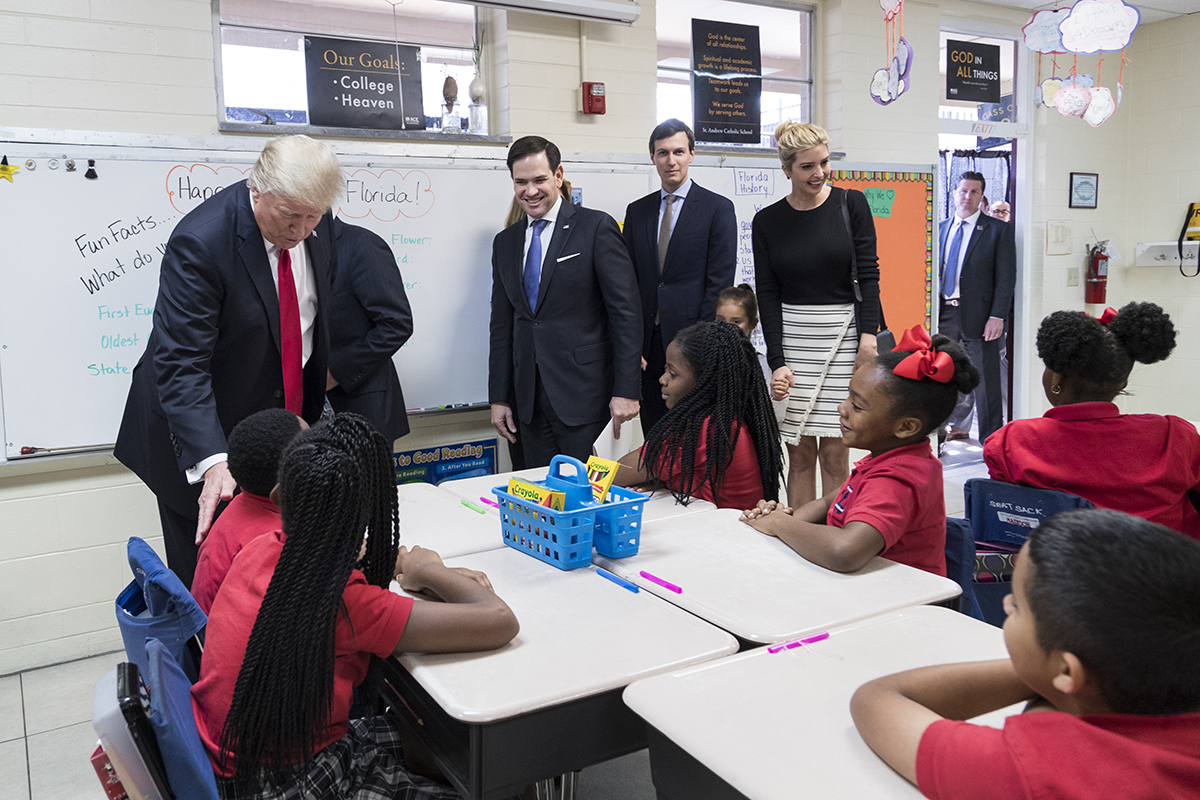- Slug: Trump Education Department. 890 words.
- Photo available below.
By Samantha Bell
Cronkite News
WASHINGTON — Arizona educators worry that President-elect Donald Trump will follow through on a campaign promise to eliminate the Department of Education, with damaging effects on the state’s public schools.
“We will drain the government education swamp and stop the abuse of your taxpayer dollars to indoctrinate America’s youth with all sorts of things that you don’t want to have our youth hearing,” Trump said at a Wisconsin rally in September.
Conservatives have wanted to dismantle the department since Congress spun it off from the the Department of Health, Education and Welfare under President Jimmy Carter.
“We will send Education BACK TO THE STATES, and Linda will spearhead that effort,” Trump said Nov. 19, announcing his pick for secretary of education, Linda McMahon.
Trump has based his argument both on culture war themes – vowing to get “transgender ideology and left-wing indoctrination OUT of our schools,” as his campaign platform put it – along with rankings that show U.S. schools lagging those of countries that spend less per pupil.
Education experts say Trump’s plan likely would entail grants that give states more control over federal education funds.
But congressional mandates wouldn’t go away, and Trump has not explained how these would be enforced – including gender protections and support for low-income students and those with disabilities and special needs.
Critics fear that direct grants could let states divert federal education funds to initiatives such as vouchers that help parents pay for private and charter school tuition or even home-schooling. That, they say, could aggravate disparities between wealthier communities and poorer or rural areas.
Arizona’s voucher program cost state taxpayers $332 million in the 2023-2024 school year, according to a study from the Grand Canyon Institute, which projects the program will balloon to $429 million in the current school year.
Critics are especially concerned about Title I, which provides extra funding for low-income schools, and special education funding under the Individuals With Disabilities Education Act, or IDEA.
“His plan includes giving the state direct grants, which would mean that a lot of students may lose their legal right to a fair and equal education,” said Marisol Garcia, president of the Arizona Education Association.
Before taking over the AEA, Garcia taught in low-income areas of Arizona, where many students live in extreme poverty. Lack of funding meant that students with learning disabilities were often identified later than they should have been.
“The U.S. Department of Education helps to fund support ensuring that students with disabilities, students that are English-language learners and students that are living in poverty get the additional support they need in order to be successful,” Garcia said.
The complete elimination of the department would require congressional approval. Senate Republicans have only 53 seats, well short of the 60 needed to overcome Democratic opposition.
Contrary to popular belief, curriculum decisions are made at the state and local levels, not by the federal government. Public schools are typically controlled by locally elected school boards.
Federal funding only accounts for 10% of all school funding. The rest comes from state and local taxes.
The Education Department provides K-12 schools about $28 billion per year for Title I and IDEA. It enforces guarantees of free and appropriate education for students with special needs, and a variety of civil rights protections.
One proposal would shift enforcement to the Justice Department, though education advocates worry that education cases would be low priority and that the DOJ lacks the necessary expertise.
Sen. Mark Kelly, D-Arizona, told Cronkite News he thinks Trump’s “bad” idea will only make Arizona’s school funding challenges worse.
“These vouchers have decimated funding for public schools in the state,” Kelly said. “The last thing we need is the kind of negative disruption we could get from having no Department of Education.”
A study released in September by Consumer Affairs ranked Arizona 40th on graduation rates, college entrance scores and reading and math assessments, and last for school funding and resources.
“Kids aren’t doing well in school, and something needs to be done for that to change,” said Holli Yates, a Trump supporter. “It doesn’t seem like the Department of Education is doing enough to help Arizona’s youth, and I think Trump’s plan will be what does.”
Yates moved from Mesa to California when her son was a toddler, alarmed by overcrowded classrooms and lack of attention given to her son.
Carter signed legislation in 1979 elevating the department to Cabinet status. The blowback was immediate. His challenger, Republican Ronald Reagan, proposed dismantling the department during their 1980 contest, though Congress wasn’t interested.
Max Eden, a senior fellow at the conservative American Enterprise Institute who supports abolition of the Education Department, said he doesn’t think Arizona schools should worry that the overall level of federal funding would drop.
He predicted that Trump is more likely to shrink it than dismantle it entirely. Oversight of student loans would probably go to the Treasury Department, he said, and the Department of Health and Human Services could enforce Title I.
But at the left-leaning Center for American Progress, Weadé James, the senior director for K-12 education policy, foresees severe consequences, especially to struggling states like Arizona – even if the department isn’t entirely scrapped.
James expects Trump and his allies to cut Title I funding, harming low-income schools and cutting key funding for teachers.
For more stories from Cronkite News, visit cronkitenews.azpbs.org.
